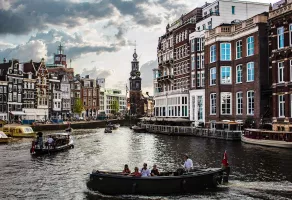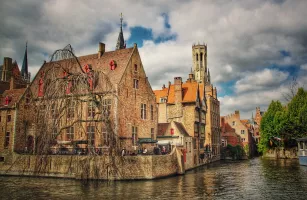The Louvre Travel Guide
The Louvre, located in Paris, France, is one of the world's largest and most famous museums. Originally built as a fortress in the late 12th century, it now houses over 38,000 objects spanning from prehistory to the 21st century. The museum's iconic glass pyramid entrance and vast collection of art, including the famous Mona Lisa, make it a must-visit destination for art enthusiasts and history buffs alike.Top Attractions in The Louvre
- The Mona Lisa
- The Venus de Milo
- The Winged Victory of Samothrace
- Napoleon III Apartments
- The Egyptian Antiquities
The Louvre is Famous for
Being home to iconic artworks like the Mona Lisa and the Venus de Milo.Top Attractions in The Louvre
- Exploring the vast collection of art and artifacts
- Admiring the stunning architecture of the museum
- Learning about art history through interactive exhibits
- Attending special exhibitions and events
What's Great about Travelling to The Louvre?
- Art enthusiasts and history buffs will be in awe of the museum's collection
- Paris offers a unique blend of culture, cuisine, and architecture
- The Louvre is a central location, making it easy to explore other attractions in the city
What's Not So Great about Travelling to The Louvre?
- The museum can get crowded, especially during peak tourist seasons
- Some may find the sheer size of the museum overwhelming to navigate
- Paris can be expensive, particularly accommodation and dining options near the museum
Travel Tips for The Louvre
- Book tickets online in advance to skip the long lines
- Wear comfortable shoes as you'll be doing a lot of walking in the museum
- Plan your visit strategically to avoid the busiest times of the day
Important The Louvre trip information
- Ideal Duration: 1-2 days to explore the museum thoroughly
- Best Time to Visit: Early mornings or late afternoons to avoid crowds
- Nearby Airports and Railway Stations: Charles de Gaulle Airport and Gare du Nord railway station
Total
4,95,000
*EXCLUDING APPLICABLE TAXES 5.0 Ratings
( 20 Reviews )
( 20 Reviews )
Per Person
70,000
*EXCLUDING APPLICABLE TAXES 5.0 Ratings
( 4 Reviews )
( 4 Reviews )
Total
4,63,000
*EXCLUDING APPLICABLE TAXES 5.0 Ratings
( 20 Reviews )
( 20 Reviews )
Total
5,55,000
*EXCLUDING APPLICABLE TAXES 5.0 Ratings
( 20 Reviews )
( 20 Reviews )
Per Person
3,92,000
*EXCLUDING APPLICABLE TAXES 5.0 Ratings
( 20 Reviews )
( 20 Reviews )
Per Person
2,88,500
*EXCLUDING APPLICABLE TAXES 5.0 Ratings
( 20 Reviews )
( 20 Reviews )
FAQ's on The Louvre
Q1: What is the best time to visit The Louvre?
The best time to visit The Louvre is during the shoulder seasons of spring (April to June) and fall (September to November) when the weather is mild, and the tourist crowds are not as overwhelming. Additionally, consider visiting on weekdays to avoid the busiest days. Special events and exhibitions may impact the ideal time to visit, so check the museum's schedule for any must-see events.
Q2: Do I need a visa to travel to The Louvre?
The Louvre is located in Paris, France, so if you are a tourist from the EU, the US, Canada, Australia, or many other countries, you can visit visa-free for up to 90 days. However, always check the current visa requirements and regulations before your trip to ensure a smooth entry.
Q3: What are the must-visit attractions in The Louvre?
The Louvre is home to iconic masterpieces like the Mona Lisa, Venus de Milo, Winged Victory of Samothrace, and many more. Don't miss the Napoleon III Apartments, the Egyptian Antiquities, and the stunning Glass Pyramid entrance. Take your time exploring the vast collection of art and history that the museum offers.
Q4: Is The Louvre a safe place to travel?
The Louvre is generally a safe place to visit, but like any major tourist destination, you should be cautious of pickpockets, especially in crowded areas. Stay vigilant with your belongings and be aware of your surroundings. Follow local laws and guidelines to ensure a safe and enjoyable visit.
Q5: What is the local currency in The Louvre and can I use credit cards?
The local currency in France is the Euro (€). While credit cards are widely accepted in most establishments, it's a good idea to have some cash on hand for smaller purchases and transactions. ATMs are readily available in the city for easy access to cash if needed.
Q6: What is the local cuisine like in The Louvre?
French cuisine is renowned worldwide for its culinary excellence. While visiting The Louvre, be sure to try classic dishes like Coq au Vin, Croissants, Escargot, and of course, French wine and cheese. Explore local cafes and restaurants near the museum for a taste of authentic French gastronomy.
Q7: What transportation options are available in The Louvre?
The Louvre is well-connected by public transportation, including the Paris Metro and buses. Taxis and ride-sharing services are also readily available for convenient travel around the city. Consider walking or biking in the area for a more leisurely exploration of the surrounding attractions.
Q8: Are there any cultural norms or etiquette I should be aware of when visiting The Louvre?
When visiting The Louvre and other cultural sites in France, it's important to show respect by dressing modestly and speaking politely. Avoid loud behavior and be mindful of the artwork and exhibits. French culture values manners and courtesy, so a simple "Bonjour" (hello) or "Merci" (thank you) can go a long way in your interactions with locals.
Q9: I am a travel agent. How can I buy travel leads of The Louvre?
Register yourself as a travel agent at agents.tripclap.com and then you can buy travel leads to The Louvre once your account is approved. For more details contact our support team at +91-8069186564 or support@tripclap.com




